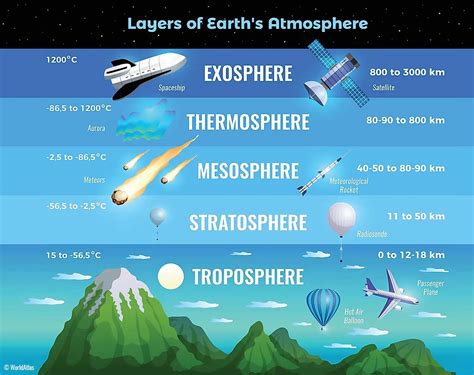Weather is a common occurrence on Earth, but do you know where it actually happens? The answer lies in the layers of the atmosphere that surround our planet.

Atmosphere and Its Layers
The atmosphere is a gaseous envelope that surrounds the Earth. It is composed of a mixture of gases, primarily nitrogen (78%) and oxygen (21%), with trace amounts of other gases. The atmosphere is divided into several layers based on temperature and composition.
Weather in the Troposphere
The weather we experience on a daily basis occurs in the lowest layer of the atmosphere, known as the troposphere. The troposphere extends from the Earth’s surface to an altitude of about 10 to 12 kilometers (6 to 7 miles).
The troposphere is characterized by decreasing temperature with increasing altitude. This temperature gradient is essential for weather phenomena because it drives air movement and creates pressure differences. The air near the Earth’s surface is warmer and less dense than the air higher up, causing it to rise. As air rises, it cools and becomes more dense, causing it to descend. This cycle of rising and descending air creates wind, clouds, and precipitation.
Other Layers of the Atmosphere
While the troposphere is where weather occurs, other layers of the atmosphere also play important roles:
- Stratosphere: Located above the troposphere, the stratosphere extends from about 12 to 50 kilometers (7 to 31 miles) in altitude. It contains the ozone layer, which protects the Earth from harmful ultraviolet radiation.
- Mesosphere: The mesosphere extends from about 50 to 85 kilometers (31 to 53 miles) in altitude. It is characterized by decreasing temperature with increasing altitude.
- Thermosphere: The thermosphere is the outermost layer of the atmosphere, extending from about 85 kilometers (53 miles) to the edge of space. It is characterized by extremely high temperatures due to the absorption of solar radiation.
Influence of Altitude on Weather
The altitude within the troposphere also influences the weather we experience. For example:
- Near the Earth’s surface: Air is warmer, more humid, and denser, often leading to clouds, precipitation, and winds.
- Middle troposphere: Air is cooler and dryer, with fewer clouds and less precipitation.
- Upper troposphere: Air is very cold and dry, with clear skies and no precipitation.
Importance of Understanding Weather Layer
Understanding the layer of the atmosphere where weather occurs is essential for:
- Forecasting: Meteorologists use this knowledge to predict weather patterns and issue weather forecasts.
- Climate modeling: Scientists use this information to develop models that simulate weather and climate patterns.
- Air pollution control: Understanding the movement of air in the troposphere is crucial for managing air pollution and improving air quality.
Conclusion
Weather occurs in the troposphere, the lowest layer of the atmosphere. This layer is characterized by decreasing temperature with increasing altitude, which drives air movement and creates the conditions necessary for weather phenomena. Other layers of the atmosphere, such as the stratosphere, mesosphere, and thermosphere, also play important roles in influencing weather patterns. By understanding the relationship between weather and the different layers of the atmosphere, we can better predict and manage weather events.
